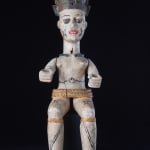Ibibio Polychrome Sculpture of a Seated Woman (perhaps Queen Victoria), 20th Century CE
Wood
8 x 27
PF.4777 (LSO)
Further images
This remarkable piece was made by the Ibibio of the Cross River area, Nigeria. It is unusually ornate, with jointed arms (and socketed hands), a solid build, a highly detailed...
This remarkable piece was made by the Ibibio of the Cross River area, Nigeria. It is unusually ornate, with jointed arms (and socketed hands), a solid build, a highly detailed face, black designs over a white ground, and surmounted with what it evidently intended to be a European crown (with fleurs de lis). The hole in the base conforms that it is a puppet, used by the Ekon society to satirise prominent members of society. It is possible – given the date of the piece – that the intended victim is actually Queen Victoria or Queen Mary – although this is impossible to confirm.
The Ibibio live in the Cross River area of modern day Nigeria. They are closely related to the Annang, Efik, Oron and Eket, and are believed to have originated in a migration of Egyptian Jews in the early 2nd millennium AD. They are governed by a group of elders (Ekpo Ndem Isong), presided over by village heads. Decisions are enforced by the Ekpe society, who carry out their work while masked. Their religion is technically centred upon a god named Ala, whose indulgence – in the form of increased female fertility and good crops – is obtained through the Ogbom ceremony. In practical terms, religion is based upon ancestor worship, specifically those who achieved the highest status (i.e. house or village heads) while living. They control the lives of their descendents, and they “use” the Ekpe society to signal their displeasure if they are neglected. The Ibibio are one of the few African groups who believe twins to be unlucky, and infanticide was common.
The light colouring is anecdotal evidence that this represents a European, but white is also used to allude to the world of the spirits, death, purity and witchcraft-repelling powers. The crown and high-heeled shoes, however, are less ambiguous. The small black symbols are Nsibidi symbols, a secret “language” of the Ekpe society. This is a genuinely important and impressive piece of African art.
The Ibibio live in the Cross River area of modern day Nigeria. They are closely related to the Annang, Efik, Oron and Eket, and are believed to have originated in a migration of Egyptian Jews in the early 2nd millennium AD. They are governed by a group of elders (Ekpo Ndem Isong), presided over by village heads. Decisions are enforced by the Ekpe society, who carry out their work while masked. Their religion is technically centred upon a god named Ala, whose indulgence – in the form of increased female fertility and good crops – is obtained through the Ogbom ceremony. In practical terms, religion is based upon ancestor worship, specifically those who achieved the highest status (i.e. house or village heads) while living. They control the lives of their descendents, and they “use” the Ekpe society to signal their displeasure if they are neglected. The Ibibio are one of the few African groups who believe twins to be unlucky, and infanticide was common.
The light colouring is anecdotal evidence that this represents a European, but white is also used to allude to the world of the spirits, death, purity and witchcraft-repelling powers. The crown and high-heeled shoes, however, are less ambiguous. The small black symbols are Nsibidi symbols, a secret “language” of the Ekpe society. This is a genuinely important and impressive piece of African art.









